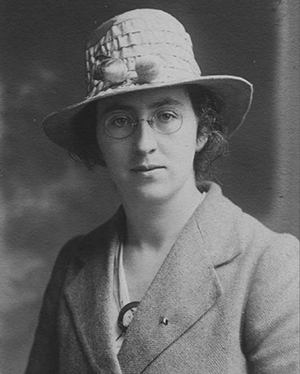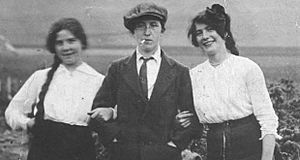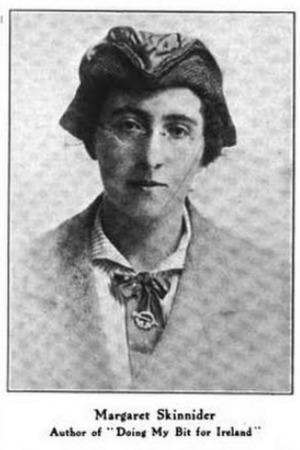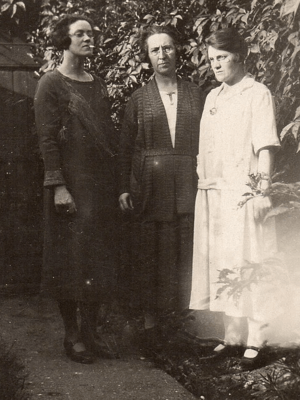Margaret Skinnider facts for kids
Quick facts for kids
Margaret Frances Skinnider
|
|
|---|---|

Skinnider c. 1914
|
|
| Born | 28 May 1892 Coatbridge, Lanarkshire, Scotland |
| Died | 10 October 1971 (aged 79) Glengeary, Dublin, Ireland |
| Allegiance | Irish Republic |
| Years of service | 1915–1923 |
| Unit | Irish Citizen Army Cumann na mBan |
| Battles/wars | Easter Rising Irish War of Independence Irish Civil War |
| Other work | Suffragette, Teacher, Trade Unionist |
Margaret Frances Skinnider (born May 28, 1892 – died October 10, 1971) was a brave woman from Coatbridge, Scotland. She believed in big changes for her country. She also believed that women should have equal rights.
Margaret fought in the 1916 Easter Rising in Dublin. She was a skilled shooter, also known as a sniper. She was the only woman injured during the fighting. People praised her courage as a scout, someone who gathers information. A writer for The New York Times called her "the schoolteacher turned sniper."
Contents
Margaret Skinnider's Early Life
Margaret Frances Skinnider was born in 1892. Her parents were Irish and lived in Coatbridge, Scotland. She became a mathematics teacher. Margaret joined a group called Cumann na mBan in Glasgow. This group was for women who supported Irish independence.
She also took part in the movement for women to get the right to vote. Margaret learned to shoot at a rifle club. During her trips to Ireland, she met Constance Markievicz. Margaret then helped to secretly bring items for explosions into Dublin. She even hid some in her hat! She also tested dynamite with Madeleine ffrench-Mullen in the hills around Dublin.
Margaret saw the very poor parts of Dublin with Markievicz. She wrote that she didn't think there was a worse place anywhere. She described streets full of dirt and buildings that looked like they had been shot at.
Margaret Skinnider and the Easter Rising
During the Easter Rising, Margaret Skinnider had many jobs. She was a scout, a message runner, and a sniper. Sometimes she dressed as a boy to deliver messages. She fought against the British Army in Dublin. This happened at the College of Surgeons and St. Stephen's Green. General Michael Mallin and Markievicz led her group. Margaret was in charge of four men. She was known as an excellent shooter.
Margaret was badly hurt during the fighting. She was shot three times. This happened when she tried to burn down houses on Harcourt Street. She wanted to stop British soldiers from escaping. Nora O'Daly and Madeleine ffrench-Mullen helped her. They gave her first aid at the College of Surgeons.
Nora Connolly O'Brien spoke about Margaret's leadership. She said that Margaret was in charge of her squad. Even William Partridge, a famous working-class leader, accepted her as their leader.
In her own book, Doing my bit for Ireland, Margaret described being a sniper. She wrote about the smoke and noise of the fighting. She could see British soldiers on a rooftop. She also heard their shots hitting her building. Margaret said she saw the men she aimed at fall.
Margaret also wrote about women fighting in the war. She said that Commandant Mallin didn't want a woman to take such risks. But Margaret argued that women had the same right to risk their lives as men. She said the new Irish Republic's plan for government said women were equal to men. It was the first time a country's plan included equal voting rights for women.
Gerry Adams, the leader of Sinn Féin, quoted Margaret's words in a speech in 2006.
Margaret was seriously injured in the Easter Rising. One bullet missed her spine by a tiny bit. Other rebels carried her to the College of Surgeons. She stayed there until the order to surrender came. Then she went to St Vincent’s Hospital. For two weeks, Margaret suffered greatly. The bullets that hit her expanded inside her body. She also had a fever and lung problems.
Her parents were wrongly told that Margaret had died or was paralyzed. This was cleared up when Nora and Ina Connolly visited her. After weeks in the hospital, she escaped her guards. She then got a special pass to go back to Scotland. She also visited some rebel prisoners in England.
Fighting for Independence
Margaret returned to Dublin later that year. But she soon went to the United States. She was worried about being arrested. In America, she raised money for the fight for independence. She also gave talks with other women who fought in the Easter Rising. Margaret wrote and published her book, Doing my Bit for Ireland, in New York.
Margaret came back to Ireland in 1917 and became a teacher in Dublin. During the Irish War of Independence, she was arrested and put in prison. In the Irish Civil War, she helped by carrying messages. She worked for the leaders who were against the peace treaty. After Harry Boland died, she managed the money for the Irish Republican Army.
She was arrested again in December 1922. She was held in prison for having a gun and bullets. While in prison, she helped train other prisoners. She stayed in prison until November 1923. This was six months after the Civil War ended. She then returned to Dublin and worked with Jim Larkin's Workers' Union of Ireland.
In 1925, Margaret asked for a special payment for her injuries from the Easter Rising. But her request was refused for a long time. This was because she was a woman. Also, she had fought against the peace treaty in the Civil War. She finally received her payment in 1938. This happened after Eamon De Valera's party came to power.
Margaret Skinnider's Later Life
After leaving prison, Margaret worked as a teacher. She taught at Kings Inn Street Sisters of Charity Primary School in Dublin. She taught there until she retired in 1961. She was a member of the Irish National Teachers' Organisation (INTO) for her whole teaching career. She even became its President in 1956.
Margaret also actively fought for women's rights. She especially worked against the rule that stopped women from working after they got married. In 1946, she joined a political party called Clann na Poblachta. She was on its main committee. She also ran as a candidate for the party in local elections in 1950. In 1954 and 1957, she was suggested as a candidate for the Seanad Eireann. Her connection to the INTO made her a strong choice for the role.
Margaret Skinnider spent her last years in Glenageary, County Dublin. She passed away on October 10, 1971. She was buried next to Markievicz in Glasnevin Cemetery, Dublin. Margaret was only the third woman buried in the "Republican plot" area of Glasnevin. Markievicz was the first, and James Connolly's wife Lillie was the second.




